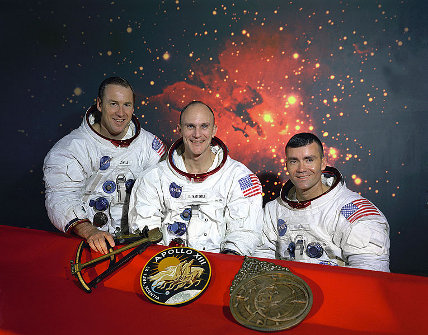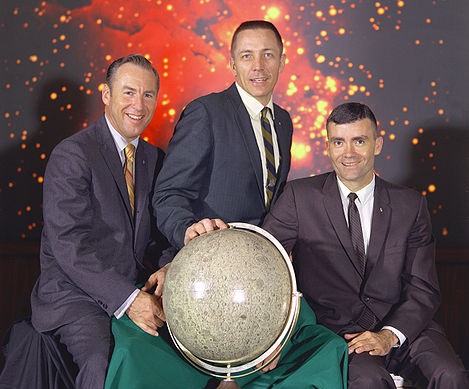Commander James A. Lovell, Command Module pilot John L. Swigert, and Lunar Module pilot Fred W. Haise. Photo courtesy NASA.
On April 11, 1970, an exploding oxygen tank nearly claimed the lives of Apollo 13 astronauts James Lovell, John Swigert, and Fred Haise. The explosion crippled the Service Module and the Command Module did not have enough power to support them for the entire trip home, so the astronauts used the Lunar Module as a lifeboat for their trip back to Earth. They were aided by Houston’s Mission Control team and the Mission Evaluation Room (MER) team, who worked around the clock to find ways to keep those men alive and get them home.
The astronauts struggled to work with extremely low power resources in very cold conditions. The Lunar Module did not have enough water, and though there was plenty of oxygen, the carbon dioxide removal system on the LM wasn’t enough to support the crew of three for four days. With the help of MER and Mission Control, the astronauts were able to splice together the CM’s carbon dioxide removal canisters with the LM canisters via “the mailbox,” a hack that saved their lives. The story (as we know) ended happily, and today we call the mission “a successful failure.”*

Commander James A. Lovell, original Command Module pilot Thomas K. Mattingly (grounded at the last minute because of exposure to German measles), and Lunar Module pilot, Fred W. Haise. Photo courtesy NASA.
In commemoration of the Apollo 13 anniversary last month, Nancy Atkinson (no relation) at Universe Today ran a blog series titled “13 Things That Saved Apollo 13,” based on interviews with Jerry Woodfil, an engineer with MER during the rescue. It gives a great behind-the-scenes look at some of the engineers on the ground and fascinating insight into the things that could have—but did not—go wrong that day. Here is a complete list of her posts that I encourage you all to check out:
Part 2: The Hatch That Wouldn’t Close
Part 3: Charlie Duke’s Measles
Part 4: Using the LM for Propulsion
Part 5: Unexplained Shutdown of the Saturn V Center Engine
Part 6: Navigating by Earth’s Terminator
Part 8: The Command Module Wasn’t Severed
Part 12: Lunar Orbit Rendezvous
Part 13: The Mission Operations Team
Now is also a great time to re-watch two favorites of mine: Apollo 13, the 1995 film on the mission, and 1998’s From the Earth To the Moon, the 12-part miniseries on the Apollo program. (The Apollo 13 episode is titled “We Interrupt This Program.”) Apollo 13, though it took some liberties, is what a friend affectionately dubbed “competency porn.” The film is two hours of watching people be exceptionally good at what they do. When the engineers dump the bin of components on the table and explain that this is what the astronauts have to work with and they have only that to solve the problem, I cheer silently every time. It’s absolutely thrilling to watch scientists accomplish so much given the incredible limitations. From the Earth to the Moon is just great television from beginning to end, including the Apollo 13 episode.
For more: the National Air and Space Museum sponsored a 40th anniversary panel discussion, with Jim Lovell, Fred Haise, Apollo 16 command module pilot Ken Mattingly, and mission controller Gene Kranz. National Air and Space Museum Director John R. Dailey and Senator John H. Glenn, astronaut and first American to orbit the Earth, introduced the event. The full webcast is archived here.
I’ll end with a quotation from Richard Nixon, from his speech presenting the Presidential Medal of Freedom to the Mission Operations Team:
We often speak of scientific “miracles”—forgetting that these are not miraculous happenings at all, but rather the product of hard work, long hours and disciplined intelligence.
The men and women of the Apollo XIII Mission Operations Team performed such a miracle, transforming potential tragedy into one of the most dramatic rescues of all time. Years of intense preparation made this rescue possible. The skill coordination and performance under pressure of the mission operations team made it happen. Three brave astronauts are alive and on Earth because of their dedication and because at the critical moments the people of that team were wise enough and self-possessed enough to make the right decisions. Their extraordinary feat is a tribute to man’s ingenuity, to his resourcefulness, and to his courage.
So it is.
*This is of course the quick and dirty version: for further reading you can start with Wikipedia, move on to the NASA website, and eventually pick up Lost Moon, James Lovell’s account of what happened.
Torie Atkinson longs for something as inspirational as the Apollo program to happen in her own lifetime. Shoutout to Arachne Jericho for pointing out the Universe Today series.










